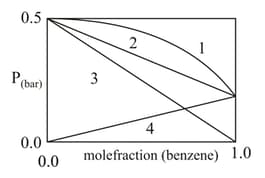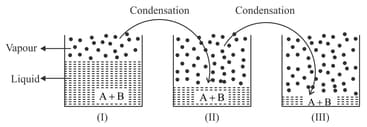Raoult's Law
Raoult's Law: Overview
This topic covers concepts, such as, Raoult's Law, Raoult's Law for an Ideal Solution of Two Liquid Components, Calculation of Composition of Liquid and Vapour in a Solution & Temperature versus Composition Phase Diagram for an Ideal Solution etc.
Important Questions on Raoult's Law
Two liquid and form an ideal solution. The ratio of vapour pressures of pure liquids and are . if the mole- fraction of in the liquid solution at equilibrium with vapours, is , then the mole fraction of in the vapour is
The following graph represents variation of boiling point with composition of liquid and vapours of binary liquid mixture. The graph is plotted at constant pressure, for a solution of mole fraction

Which of the following statement(s) is correct.
The vapour pressure of water is at . Now, calculate the vapour pressure of molar solution of a solute in it.
How we can prove that Raoult’s law as a special case of Henry’s law?
Raoult's law becomes a special case of Henry's law when . In this equation, is
Raoult's law becomes a special case of Henry's law when becomes equal to _____.
"Enter the correct answer as or ."
Condition at which Raoult's law becomes a special case of Henry's law?
Raoult's law becomes a special case of Henry's law when becomes equal to .
At , the vapour pressure of a solution containing one mole of hexane and three moles of heptane is of . At the same temperature, if one more mole of heptane is added to this solution, the vapour pressure of the solution increases by of . What is the vapour pressure in of heptane in its pure state?
A mixture of toluene and benzene forms a nearly ideal solution. Assume and to be the vapor pressures of pure benzene and toluene, respectively. The slope of the line obtained by plotting the total vapor pressure to the mole fraction of benzene is:
In the pressure vs. the mole fraction of benzene curves/lines shown below, the total vapour pressure of an ideal mixture of benzene and toluene will follow the curve/line.

Vapour pressure of benzene is . When of non-volatile solute is dissolved in benzene, benzene solution has vapour pressure . Calculate the molar mass of the solute in ( molar mass of benzene = ).
Raoult's law states that for a solution of volatile liquids, the partial vapour pressure of each component of the solution is directly proportional to its mole fraction present in solution.
Vapour pressure of and mixture at is given by where is mole fraction of Solution is prepared by mixing of and of and if the vapours are removed and condensed into liquid and again brought to the temperature of If the ratio of mole fraction of in vapour state and mole fraction of in vapour state above the condensate is find value of is -
At the vapour pressure (in torr) of methyl alcohol (A) and ethyl alcohol solution is represented by: where is mole fraction of
methyl alcohol. The value of at and at are :
The mass of a non-volatile solute of molar mass that should be dissolved in of octane to lower its vapour pressure by is :
The vapour pressure of benzene at is lowered by by dissolving of a non-volatile substance in of benzene. The vapour pressure of pure benzene at is . The molecular mass of the substance will be :
Which condition is not satisfied by an ideal solution?
At , vapour pressure in torr of methanol and ethanol solution is where is the mole fraction of methanol. Hence


